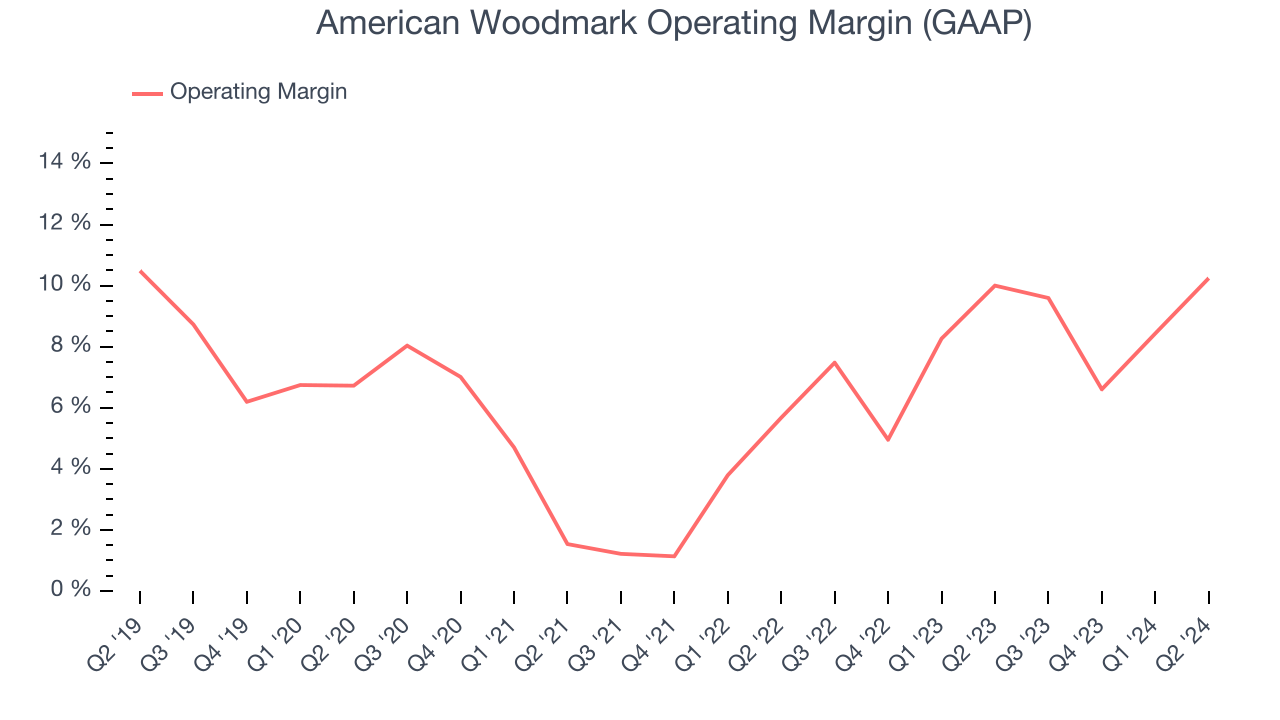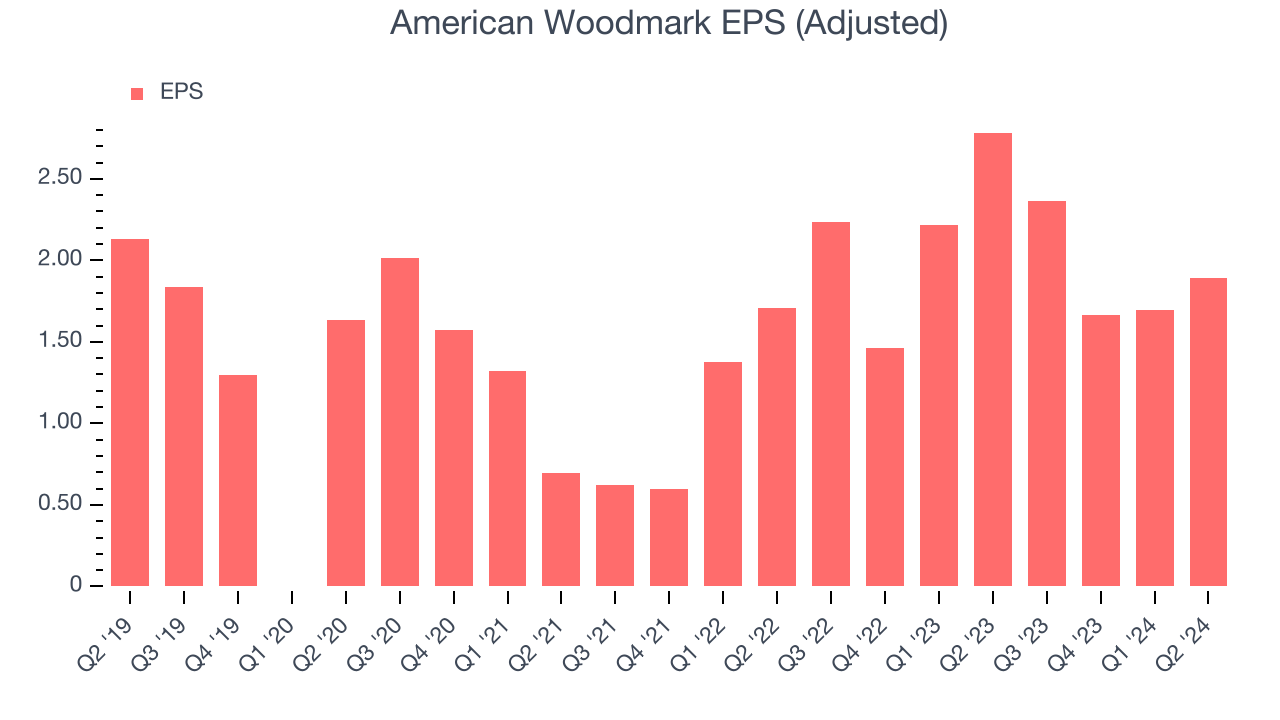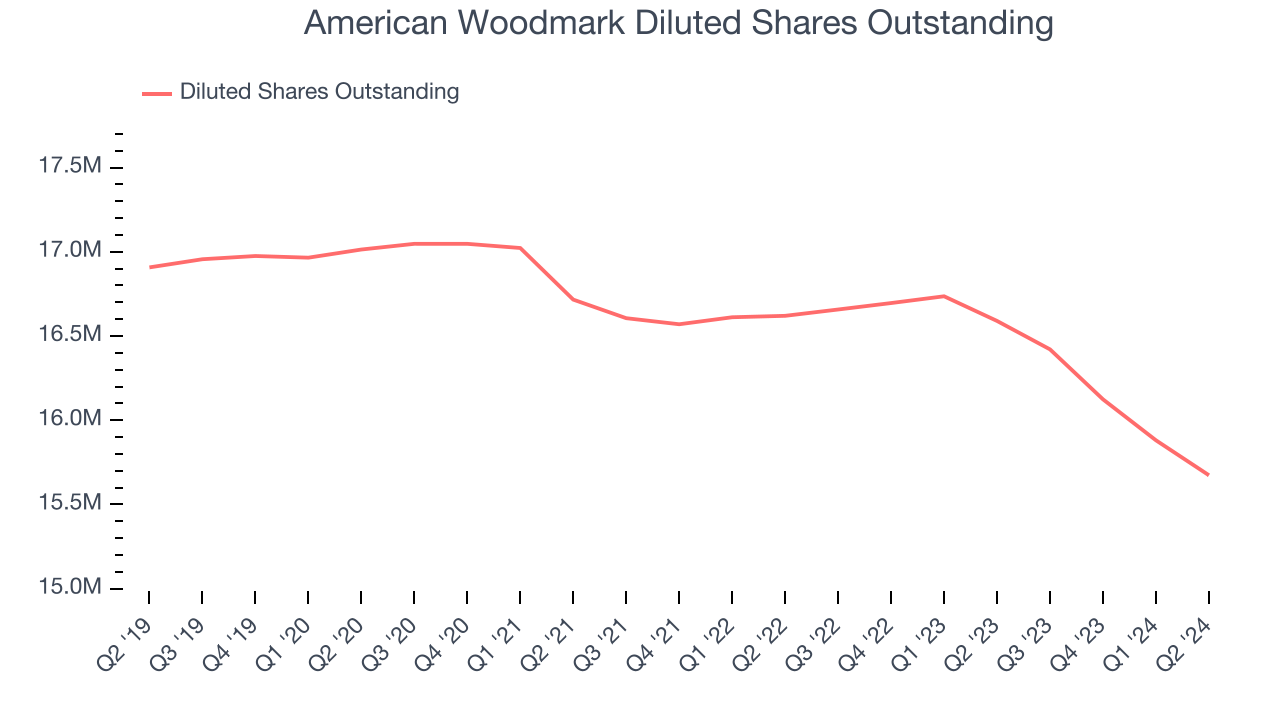Cabinet manufacturing company American Woodmark (NASDAQ:AMWD) missed analysts’ expectations in Q2 CY2024, with revenue down 7.9% year on year to $459.1 million. It made a non-GAAP profit of $1.89 per share, down from its profit of $2.78 per share in the same quarter last year.
Is now the time to buy American Woodmark? Find out by accessing our full research report, it’s free.
American Woodmark (AMWD) Q2 CY2024 Highlights:
- Revenue: $459.1 million vs analyst estimates of $475.4 million (3.4% miss)
- EPS (non-GAAP): $1.89 vs analyst expectations of $2.37 (20.3% miss)
- EBITDA guidance for the full year is $235 million at the midpoint, below analyst estimates of $243.2 million
- Gross Margin (GAAP): 20.2%, down from 22% in the same quarter last year
- EBITDA Margin: 13.7%, down from 15.1% in the same quarter last year
- Market Capitalization: $1.56 billion
“Our team delivered net sales growth in the new construction market, but this was more than offset by weaker than projected demand in the remodel market,” said Scott Culbreth, President and CEO.
Starting as a small millwork shop, American Woodmark (NASDAQ:AMWD) is a cabinet manufacturing company that helps customers from inspiration to installation.
Home Construction Materials
Traditionally, home construction materials companies have built economic moats with expertise in specialized areas, brand recognition, and strong relationships with contractors. More recently, advances to address labor availability and job site productivity have spurred innovation that is driving incremental demand. However, these companies are at the whim of residential construction volumes, which tend to be cyclical and can be impacted heavily by economic factors such as interest rates. Additionally, the costs of raw materials can be driven by a myriad of worldwide factors and greatly influence the profitability of home construction materials companies.
Sales Growth
A company’s long-term performance can indicate its business quality. Any business can put up a good quarter or two, but many enduring ones tend to grow for years. Over the last five years, American Woodmark grew its sales at a weak 1.8% compounded annual growth rate. This shows it failed to expand in any major way and is a rough starting point for our analysis. 
We at StockStory place the most emphasis on long-term growth, but within industrials, a half-decade historical view may miss cycles, industry trends, or a company capitalizing on catalysts such as a new contract win or a successful product line. American Woodmark’s history shows it grew in the past but relinquished its gains over the last two years, as its revenue fell by 3.9% annually.
This quarter, American Woodmark missed Wall Street’s estimates and reported a rather uninspiring 7.9% year-on-year revenue decline, generating $459.1 million of revenue. Looking ahead, Wall Street expects sales to grow 5.7% over the next 12 months, an acceleration from this quarter.
Today’s young investors won’t have read the timeless lessons in Gorilla Game: Picking Winners In High Technology because it was written more than 20 years ago when Microsoft and Apple were first establishing their supremacy. But if we apply the same principles, then enterprise software stocks leveraging their own generative AI capabilities may well be the Gorillas of the future. So, in that spirit, we are excited to present our Special Free Report on a profitable, fast-growing enterprise software stock that is already riding the automation wave and looking to catch the generative AI next.
Operating Margin
Operating margin is an important measure of profitability as it shows the portion of revenue left after accounting for all core expenses–everything from the cost of goods sold to advertising and wages. It’s also useful for comparing profitability across companies with different levels of debt and tax rates because it excludes interest and taxes.
American Woodmark was profitable over the last five years but held back by its large expense base. It demonstrated paltry profitability for an industrials business, producing an average operating margin of 6.4%. This result isn’t too surprising given its low gross margin as a starting point.
On the bright side, American Woodmark’s annual operating margin rose by 1.6 percentage points over the last five years

This quarter, American Woodmark generated an operating profit margin of 10.2%, in line with the same quarter last year. This indicates the company’s cost structure has recently been stable.
EPS
We track the long-term growth in earnings per share (EPS) for the same reason as long-term revenue growth. Compared to revenue, however, EPS highlights whether a company’s growth was profitable.
American Woodmark’s full-year EPS grew at a remarkable 12.4% compounded annual growth rate over the last four years, better than the broader industrials sector.

Like with revenue, we also analyze EPS over a shorter period to see if we are missing a change in the business. American Woodmark’s EPS grew at an astounding 32.9% compounded annual growth rate over the last two years, higher than its 3.9% annualized revenue declines. This tells us management adapted its cost structure in response to a challenging demand environment.
Diving into the nuances of American Woodmark’s earnings can give us a better understanding of its performance. While we mentioned earlier that American Woodmark’s operating margin was flat this quarter, a two-year view shows its margin has expanded 4.6 percentage points while its share count has shrunk 5.7%. Improving profitability and share buybacks are positive signs for shareholders as they juice EPS growth relative to revenue growth. 
In Q2, American Woodmark reported EPS at $1.89, down from $2.78 in the same quarter last year. This print missed analysts’ estimates, but we care more about long-term EPS growth than short-term movements. Over the next 12 months, Wall Street expects American Woodmark to grow its earnings. Analysts are projecting its EPS of $7.61 in the last year to climb by 24.2% to $9.45.
Key Takeaways from American Woodmark’s Q2 Results
We struggled to find many strong positives in these results. Its revenue, EPS, and full-year EBITDA guidance fell short of Wall Street’s estimates. Overall, this was a weaker quarter. The stock traded down 7.9% to $91.99 immediately after reporting.
American Woodmark may have had a tough quarter, but does that actually create an opportunity to invest right now? When making that decision, it’s important to consider its valuation, business qualities, as well as what has happened in the latest quarter. We cover that in our actionable full research report which you can read here, it’s free.
